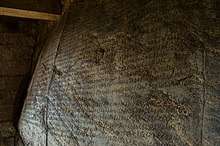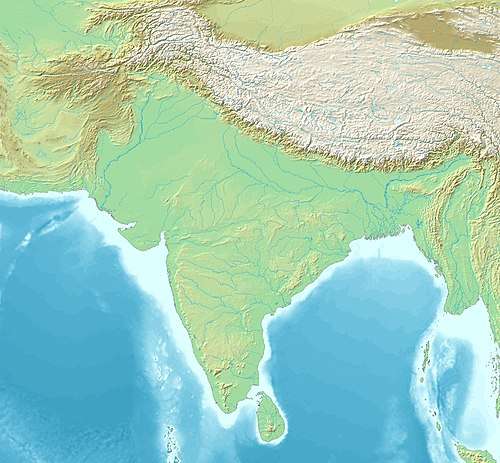Dhauli
Dhauli is located on the banks of the river Daya, 8 km south of Bhubaneswar in Odisha, India. It is a hill with vast open space adjoining it, and has major Edicts of Ashoka engraved on a mass of rock, by the side of the road leading to the summit of the hill.


Significance
Dhauli hill is presumed to be the area where the Kalinga War was fought.[1]
The Rock Edicts found here include Nos. I-X, XIV and two separate Kalinga Edicts.[2] In Kalinga Edict VI, he expresses his concern for the "welfare of the whole world". The rock-cut elephant above the Edicts is the earliest Buddhist sculpture of Odisha. The stone elephant shows the animal's foreparts only, though it has a fine sense of form and movement.[3] It is considered as one of the few remains of Mauryan art.[3]
Ashoka had a special weakness for Dhauli, where the battle was fought. The Daya river is said to have turned red with the blood of the many deceased after the battle, and enabled Ashoka to realize the magnitude of horror associated with war. He saw to it that Dhauli became an important centre of Buddhist activities. He built several chaityas, stupas and pillars there. He instructed that hermitages be excavated where recluses could meditate, issued instructions to be inscribed for officials, expounded the main principles of dandaniti (strict enforcement of laws) for the public, and thereby provided special status to his new kingdom including the stupas at Dhauli.[4]
On the top of the hill, a dazzling white peace pagoda has been built by the Japan Buddha Sangha and the Kalinga Nippon Buddha Sangha in the 1970s.[5]
Gallery
 Picture of Dhauli Light and Sound Show
Picture of Dhauli Light and Sound Show Light and sound show in Dhaulagiri
Light and sound show in Dhaulagiri- Sleeping Buddha statue at Dhauli Shanti Stupa
 Lion Sculpture at the entrance of Dhauli Shanti Stupa
Lion Sculpture at the entrance of Dhauli Shanti Stupa
References
- "Kalinga War and its impact on Ashoks". India Video. Retrieved 2 April 2011.
- Lahiri, Nayanjot (2015). Ashoka in Ancient India. Harvard University Press. p. 425. ISBN 9780674915251.
- Singh, Upinder (2008). A History of Ancient and Early Medieval India: From the Stone Age to the 12th Century. Pearson Education India. p. 361. ISBN 9788131711200.
- "Dhauli Hills, Bhubaneswar, Odisha". Retrieved 2 April 2011.
- "Dhauli". Odisha Tourism, Government of Odisha. Retrieved 3 August 2018.
External links
| Wikimedia Commons has media related to Dhauli. |
| Edicts of Ashoka (Ruled 269–232 BCE) | |||||
| Regnal years of Ashoka |
Type of Edict (and location of the inscriptions) |
Geographical location | |||
| Year 8 | End of the Kalinga war and conversion to the "Dharma" |  Udegolam Nittur Brahmagiri Jatinga Rajula Mandagiri Yerragudi Sasaram Barabar Kandahar (Greek and Aramaic) Kandahar Khalsi Ai Khanoum (Greek city) | |||
| Year 10[1] | Minor Rock Edicts | Related events: Visit to the Bodhi tree in Bodh Gaya Construction of the Mahabodhi Temple and Diamond throne in Bodh Gaya Predication throughout India. Dissenssions in the Sangha Third Buddhist Council In Indian language: Sohgaura inscription Erection of the Pillars of Ashoka | |||
| Kandahar Bilingual Rock Inscription (in Greek and Aramaic, Kandahar) | |||||
| Minor Rock Edicts in Aramaic: Laghman Inscription, Taxila inscription | |||||
| Year 11 and later | Minor Rock Edicts (n°1, n°2 and n°3) (Panguraria, Maski, Palkigundu and Gavimath, Bahapur/Srinivaspuri, Bairat, Ahraura, Gujarra, Sasaram, Rajula Mandagiri, Yerragudi, Udegolam, Nittur, Brahmagiri, Siddapur, Jatinga-Rameshwara) | ||||
| Year 12 and later[1] | Barabar Caves inscriptions | Major Rock Edicts | |||
| Minor Pillar Edicts | Major Rock Edicts in Greek: Edicts n°12-13 (Kandahar) Major Rock Edicts in Indian language: Edicts No.1 ~ No.14 (in Kharoshthi script: Shahbazgarhi, Mansehra Edicts (in Brahmi script: Kalsi, Girnar, Sopara, Sannati, Yerragudi, Delhi Edicts) Major Rock Edicts 1-10, 14, Separate Edicts 1&2: (Dhauli, Jaugada) | ||||
| Schism Edict, Queen's Edict (Sarnath Sanchi Allahabad) Lumbini inscription, Nigali Sagar inscription | |||||
| Year 26, 27 and later[1] |
Major Pillar Edicts | ||||
| In Indian language: Major Pillar Edicts No.1 ~ No.7 (Allahabad pillar Delhi pillar Topra Kalan Rampurva Lauria Nandangarh Lauriya-Araraj Amaravati) Derived inscriptions in Aramaic, on rock: | |||||